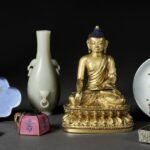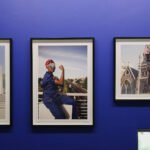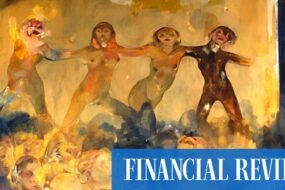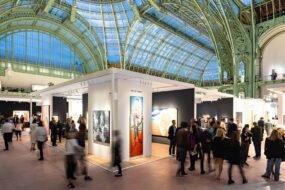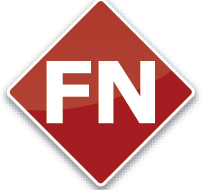
Galleries at the fourth edition of Art Basel Paris (until 26 October) reported major sales to their core clients yesterday (21 October), during the fair’s new VIP slot. Among these are a $23m Gerhard Richter’s Abstraktes Bild (Abstract Painting) (1987) at Hauser & Wirth, Modigliani’s Jeune fille aux macarons (Young Woman with Hair in Side Buns) (1918) at Pace for just under $10m and a Ruth Asawa sculpture at David Zwirner for $7.5m.
Art fairs, however, are a frenzy not just on the fair floor, but behind the scenes too. At Art Basel, hardly a season goes by without the company announcing changes to its shows and additions to its portfolio. It chief executive Noah Horowitz spoke to The Art Newspaper about some of its new features—as well as its forthcoming Doha debut.
The Art Newspaper: You’ve introduced Avant Première this year, for which galleries nominate around five people to enter the fair on the Tuesday afternoon, before the First Choice opening on Wednesday morning. What feedback from the past edition of Art Basel Paris prompted you to instate this?
Noah Horowitz: The initiative came directly from gallery feedback after last year’s edition. Many told us they wanted more time and breathing room to connect with key collectors before the pace of the main fair kicked in. This is also driven by supply/demand fundamentals: the number and quality of professional audiences seeking to attend Art Basel Paris relative to the space available in the Grand Palais demanded a thoughtful solution.
When we extended Basel’s VIP preview from one to two days a decade ago, it transformed our galleries’ experience at the fair. I very much hope Avant-Première can have a similar impact here in Paris.
Might the decision to add an extra layer of exclusivity to the fair feel counter to the need to open up the art market to new collectors?
When access is designed around focus and quality, everyone benefits. The goal here isn’t to close doors but to create a meaningful and dedicated space for galleries and their clients to connect. Given that the galleries choose exactly who to invite, I would expect the guests to represent a full spectrum—from the newest entrants to established collectors.
Art Basel is also renaming its VIP relations team that of ‘collector and institutional relations’. What evolution in the nature of collecting are you trying to address with this change?
We’re not redefining “VIP” for the sake of terminology, we’re refining it to better reflect how the art world, and our audiences, have evolved. Our responsibility to our clients is to constantly interrogate who our audiences are and how we engage them. As our platform grows globally, we’re laser-focused on segmenting our audiences more thoughtfully so we can elevate their experience and deliver greater value to our galleries and partners.
There are clear distinctions between how we connect with private collectors and institutions—the patrons and professionals at the core of the ecosystem—and how we cultivate a new generation of buyers, art enthusiasts and broader audiences in dedicated ways. The definition of ‘VIP’ is therefore by its nature dynamic: it evolves as the ecosystem does.
With Carly Murphy joining us in a new role as global head of collector and institutional relations, we’re setting an intention that our focus is on relationships that serve the unique demands of each audience.
With Art Basel Qatar and Frieze Abu Dhabi joining the existing Art Dubai next year, there will soon be three international art fairs taking place in the Gulf within a five-month span. How do you respond to concerns about whether the region’s art market is deep enough to absorb this?
“The growing activity across the Gulf reflects both the dynamism of the region’s cultural landscape and the potential of its market. I see it as a moment of expansion, not saturation.
At Art Basel, our approach has been very intentional, both in the partnerships we have forged and in how we’ve structured our business. Our first criterion was timing: we wanted a moment that would attract a global audience, and a fair at the top of February—ahead of Art Basel Hong Kong—is ideal.
The foundation for Art Basel Qatar is the extraordinary investment the country has made in arts and culture over two decades under the singular vision of Her Excellency Sheikha Al-Mayassa, from its museums and institutions to its support for artists and education.”
Since the original Basel fair, Art Basel has launched in the US, France, and Hong Kong. Those respective regions represented a considerably greater share of the global market than Qatar and even the wider Middle East do today. What is the difference in strategy behind launching in Qatar, compared to the other four territories in which Art Basel holds shows?
When we launched in Miami Beach, Hong Kong, and Paris, we were responding to mature market dynamics. In Doha, we’re responding to vision and to a country that has made long-term cultural investment part of its national identity.
Wherever we work, our strategy is always partnership driven and deeply sensitive to local context. We do not replicate fairs; and with Art Basel Qatar, we are co-creating something new with our partners that reflects the local ecosystem while empowering it with Art Basel’s global network. Qatar is representative of how we think about our global role: less as an exporter of a model, more as a collaborator in shaping what an art fair can mean in a new cultural context.
What will define success for the Doha fair? Galleries selling out their stands? Or something else?
As Art Basel Qatar establishes itself, we expect to grow and advance the local collector base in Doha, across the GCC and and the wider MENA region. It must also spark a dialogue with audiences across our global platform, echoing what we have accomplished with our fairs in Miami Beach and Hong Kong.
Ultimately, our goal is to build something that feels authentic to its context: a fair that both celebrates the vitality of artistic production across the region and connects it meaningfully to our global network. If galleries leave Doha saying they met new collectors, deepened existing relationships, and felt part of something distinctive and forward-looking, then we’ll have made a great start.
The latest MCH half-year report notes that the partnership with the Qatari organisations QC+ and QSI will increase profitability for the company. Can you elaborate on that?
Our partnership with Qatar and our entry into the region opens access to new markets and audiences. It expands our global reach and will create opportunities for growth across the wider portfolio. It’s a strategic collaboration that aligns closely with MCH’s ambition to build a more agile and resilient organisation for the future.
Working with Qatar Sports Investments (QSI) and QC+ allows us to combine expertise, resources and networks in ways that enhance how we operate and how we deliver value for our clients. We are delighted to have already confirmed Visit Qatar as our lead partner for Art Basel Qatar, and to have Qatar Airways as our Premium Partner for Art Basel globally.
What are the revenue streams Art Basel hopes to develop in future years?
Our primary focus will always be our fairs and the galleries that anchor them. But we’re also thinking expansively about how we use our platform to create value across the wider ecosystem.
The Art Basel Shop, which we launched in Basel last year, celebrates and extends the Art Basel experience while creating opportunities for our artist community. The Art Basel Awards which, in partnership with BOSS, we showcased in Basel earlier this year will culminate in an inaugural landmark celebration in Miami Beach this December. Next month, we continue our collaboration with Art Week Tokyo for a fifth consecutive year—bringing our expertise and global networks to spotlight the enormous depth of creativity and diversity within Tokyo’s contemporary art scene.
Beyond these initiatives, we’re investing in research, data, and audience insight— areas that directly help us understand and serve our community, and which are becoming increasingly important sources of long-term growth. We are deepening our digital offer, expanding strategic partnerships, and exploring formats that connect audiences with art in new ways across the year. In the end, all the revenue streams we pursue must reinforce our core mission: supporting galleries and artists and fostering the conversations that power the world of art.”
Is the future of the art fair tied to an experience-based economy? And if so, how do you balance the commitments of running a trade show alongside that?
The art world, like many sectors, is increasingly shaped by experience. People come to our fairs not just to transact but to connect and engage with art in meaningful ways. Our role is to integrate that energy while keeping the fair’s core purpose clear: providing the strongest possible marketplace for galleries and artists.
These elements work together rather than in competition and feed into the broader Art Basel mission.



